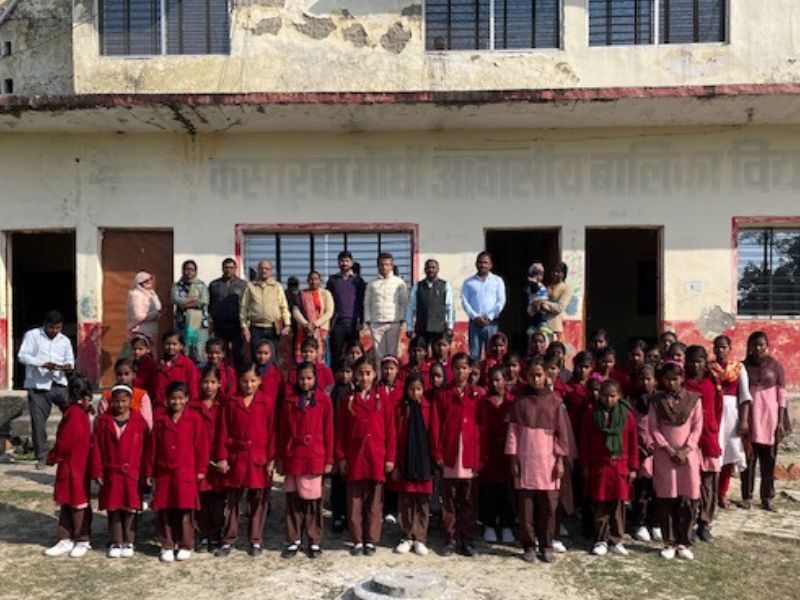 EducationWorld spoke to Aaryaman, an Indian citizen now based in Silicon Valley, whose journey from Bombay International School in Mumbai to Cornell University reflects a remarkable commitment to education and community service. Currently spearheading the ‘Daughters of India’ project, Aaryaman shares his vision for leveraging technology to uplift girls’ education in India’s underserved areas. Inspired by personal experiences in his ancestral village in Uttar Pradesh, Aaryaman discusses his aspirations to expand this initiative nationwide, igniting a wave of transformative social change through education.
EducationWorld spoke to Aaryaman, an Indian citizen now based in Silicon Valley, whose journey from Bombay International School in Mumbai to Cornell University reflects a remarkable commitment to education and community service. Currently spearheading the ‘Daughters of India’ project, Aaryaman shares his vision for leveraging technology to uplift girls’ education in India’s underserved areas. Inspired by personal experiences in his ancestral village in Uttar Pradesh, Aaryaman discusses his aspirations to expand this initiative nationwide, igniting a wave of transformative social change through education.
The Daughters of India is a commendable and overdue initiative. What are its major aims and objectives?
The Daughters of India initiative holds personal significance for me, given my familial ties to rural Uttar Pradesh. Focused on the 14 poorest districts in UP initially, the project aims to enhance educational access and quality for women. The primary objectives include improving attendance, scholastic achievements, postgraduate outcomes, and fostering broader societal support for women’s education. This initiative will set up digital classrooms through which teacher from cities like Bangalore and Mumbai will provide high-quality educational intervention to uptier the quality of educational inputs. We are confident this will lead to better outcomes for the students over a period of time. This is important as it is very difficult to get good teachers in the interiors of India.
To what extent are you satisfied with the progress of this project thus far?
At the pre-launch stage, I’m pleased with the progress of the initiative. Siddharth Nagar in UP has been identified as the initial focus area, targeting 200 students over three years. Key pre-launch steps, such as funding, government buy-in, and collaboration with relevant stakeholders, have been completed. Leveraging technology from eVidyaloka, the project is set to pilot in this region, with plans for expansion based on the pilot’s success.
What are the major impediments that block primary-secondary education of the girl child in rural India?
In addition to a lack of educational opportunities, the gender disparity in classrooms persists, with fewer girls progressing to middle and high school. This creates a cyclical pattern of limited educational opportunities for women across generations, reflecting the need for initiatives like Daughters of India.
Early marriage and motherhood of millions of under-educated and under-fed girl children reflects in weak and often stunted children and also reduced female participation in the labour force. What are the negative socio-economic outcomes of this phenomenon?
Early marriage and motherhood among under-educated girls result in weakened workforce participation, reduced economic productivity, and perpetuating a cycle of underachievement. This phenomenon hampers economic growth, limits innovation, and adversely affects overall GDP due to the underutilization of half the potential workforce.
In EducationWorld, we believe that consistently poor budgetary allocations for public education for the past seven decades is the prime cause of laggard national development and the neglect of girl children. To what extent do you agree?
Acknowledging the historical issues with budgetary allocations, recent years have seen positive changes with increased monetary allocations and legal mandates for women’s education. However, the challenge lies in pinpointing specific regions and cost centers for effective allocation. Micro-level considerations, such as infrastructure development and teacher training, are crucial for impactful spending.
While initiatives such as Daughters of India are welcome , the mountainous problem is to scale good quality primary education to the estimated 40 million girl children in public (government) schools. What are your suggestions for scaling good quality primary education?
Scaling good quality primary education to 40 million girl children in public schools requires strategic measures. Strengthening public-private partnerships, fostering a philanthropic culture, and learning from successful models in Western economies can contribute to enhancing both the scale and quality of primary education.
Since Independence India has produced excellent economists – many of whom have graced the boards of IMF, World Bank, UNDP and other international aid and term lending organisations. To what factors do you attribute their neglect of public education?
The neglect of public education by Indian economists is attributed to the absence of robust public-private partnerships and a lack of widespread philanthropic culture. Strengthening these aspects could pave the way for significant improvements in public education, mirroring successful models observed in Western economies.
Looking ahead how confident are you that India will attain its GDP goal of $30 trillion by 2047?
Expressing confidence in India’s progress, there is acknowledgment of substantial advancements in physical and software infrastructure. While significant strides have been made, emphasis is placed on addressing softer aspects of infrastructure to ensure sustainable growth towards the $30 trillion GDP goal by 2047.
Closing Comments..
The Daughters of India initiative is deemed crucial in addressing gender inequality, and it calls for widespread support. Regarding India’s GDP goal, I believe the country is making meaningful strides, with optimism for sustained growth. However, continued efforts are essential, particularly in strengthening softer aspects of the infrastructure for long-term success. Also there was a point about giving back to one’s village/town/City. We have had very good feedback from Indians wanting to give back to their hometowns and funding for 3 other schools have been tied up through their support. In january the initiative will be opened up to both resident and non-resident Indians who want to do the same. They can send an email to [email protected]
Posted in Corporate, News



























